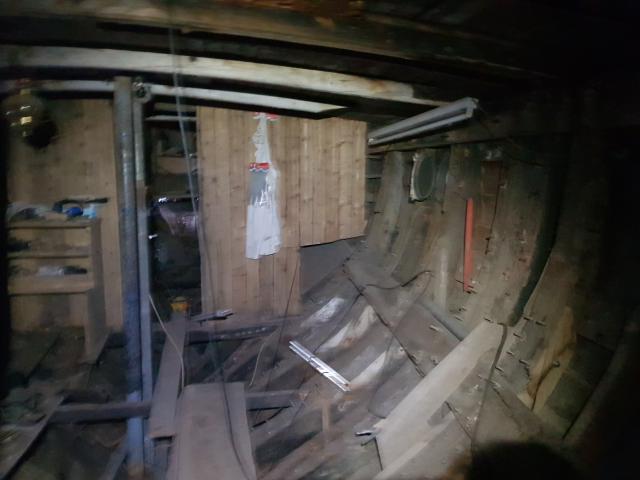Details
Construction
Dimensions
History
FROLIC was built as a pilot cutter in 1905 at Bideford by J. Westacott for Cardiff pilot Alf Edwards and was designed by a Cardiff man, C. Hancock. She was registered at Cardiff and her official number is 123172. Her hull is carvel built with five bulkheads, a bosun's store and chart space. Cardiff and Barry pilot Frank Trott who originally had the Marguerite built in 1893 purchased her as a yacht in about 1922. She is most famous as a yacht for taking part in the first “Cock of the Bristol Channel” race in 1936 when owned by Major J.S. Crosthwaite Eyre. Pilot Frank Trott came out of retirement aged 79 years to skipper her around the 200 mile course and beat on handicap the famous yacht of the period Zoraida owned and skippered by Captain Ratsey of the famous sailmaking firm. She also successfully raced on the Clyde and also out of Burnham–on–Crouch on the East Coast. By the 1950s, FROLIC had become a houseboat on the river Medway and fell over, staving in all the frames on one side. She was rescued by an architect called Peter Stubbs who bought the wreck for £50 and then repaired her himself. He then sailed her repeatedly to the Mediterranean every summer with his young family . Because of his young family and very small crew, he changed her rig to Staysail Schooner and installed a bath. He kept her for some 30 years, then sold her to a Norwegian owner. FROLIC has been under cover in a field on an island NW of Bergen in Norway since 2006.
Although this vessel is on the Overseas Watchlist, we are lacking information about this particular vessel. If you have any information about this vessel, past or present, please contact us.
Significance
1. What is the vessel’s ability to demonstrate history in her physical fabric?
Evidence for designs, functions, techniques, processes, styles, customs and habits or uses and associations in relation to events and people. How early, intact or rare these features are may impact on significance.
Frolic was built as a pilot cutter to an advanced design heavily influenced by the shallow forefoot of the Newport cutter Alpha which was built the previous year. She was in the ‘large’ class at 55’ overall length, 48’ waterline with a beam of 13.4’ and 35 tons Thames Measurement. Frolic is the only known Bristol Channel pilot cutter to be built to Lloyds +12 year survey. She was also the first to experiment with a tubular steel boom with her roller reefing gear to avoid boom breakage when severely reefed down. Her cutter rig was replaced in later ownership as a yacht when she was converted to a staysail schooner.
2. What are the vessel’s associational links for which there is no physical evidence?
Associations with people or places. Off-ship research.
Frolic’s primary associations are to the Bristol Channel where she worked and to the city of Cardiff, being built for Alf Edwards, a Cardiff pilot, and designed by C. Hancock, a local man. In later life as a yacht, she is most famous for taking part in and winning the first ‘Cock of the Bristol Channel’ race in 1936. She also successfully raced on the Clyde and the East Coast. Frolic has wider associations from time cruising in the Mediterranean, after which she spent some forty years in Norway under private ownership. Her working life is documented in a number of black and white photographs and a family photograph album also survives from the 1930s. She was one of only two pilot cutters that were included in Lloyds Register of Yachts from new, as pilot cutters. Frolic was entered on the National Register of Historic Vessels in 1999 and is listed on the Overseas Watch List being based in Norway.
3. How does the vessel’s shape or form combine and contribute to her function?
Overall aesthetic impact of the vessel, her lines, material she was built from and her setting. Does she remain in her working environment?
Frolic was designed for speed and proved herself as one of the top half dozen pilot cutters of the period. Her radical hull shape comprises an extreme cutaway forefoot, long narrow lines, a deep sternpost and an outside ballast keel. Her classic counter stern and elegant sheer are typical of the Bristol Channel pilot cutter, combined with the seaworthiness which allowed her to operate well in all weathers and the speed to get the pilot to his ship and secure the job. She was also extremely deep drafted at 9’3, with only one other Bristol Channel pilot cutter known to have exceeded this, which would have helped her stand up in bad weather.
Source: Hannah Cunliffe, NHS-UK and vessel owner (Kindly Light)
Key dates
-
1905
Vessel built by John Westcot of Bideford
Own this vessel?
If you are the owner of this vessel and would like to provide more details or updated information, please contact info@nationalhistoricships.org.uk

